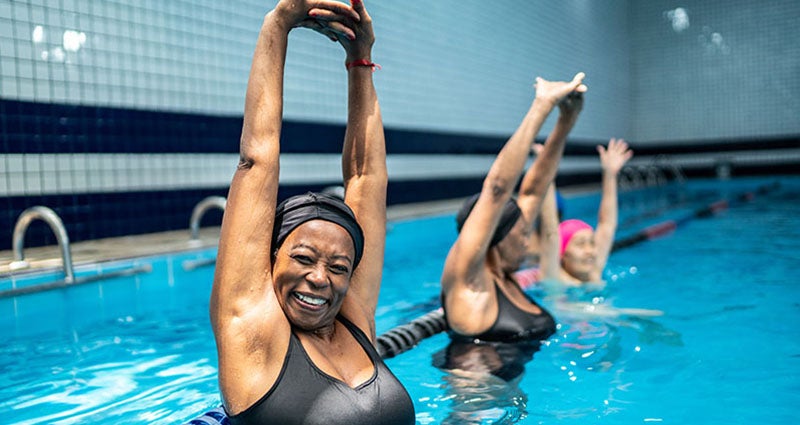Low-impact exercise ideas to boost your body and mind

Studies show that low-impact activities are good for your physical health and overall well-being.1 But what does that look like in everyday life? Well, it can be more than just going to the gym to work out. You can start low-intensity activity by taking advantage of the things you probably do already. It can be as routine as walking the dog or doing chores around the house. And if you want, you can kick it up a notch with an exercise routine or a trip to the gym. In this article, we’ll look at the health benefits of being active through low-impact exercise. We’ll also offer ideas for starting low-intensity activities that have whole-health benefits.
Benefits of low-impact exercise
Studies show that some amount of low-impact physical activity can boost both your physical and mental health.1,2 People with low physical activity have a higher risk for chronic diseases like type 2 diabetes, heart disease, cancer and depression.1,2,3,4
Low-impact exercise can improve your physical conditioning, strength, coordination, balance and flexibility.5 Physical activity can also help with weight management.3,5 A healthy weight means less stress on joints and lower risk of the health problems linked with high weight and obesity.3,5 There are also mental health benefits of being active to help with poor sleep and feelings of anxiety or depression.2,3
Low-impact exercise can also benefit older people. As people age, falls and injuries become more common. People who improve their muscle strength and flexibility have better coordination and balance.2 This can help improve mobility and may also help prevent a fall.2
A little movement can improve your function, mood and overall quality of life.2,5 It’s a dose of preventive health that you can practice every day for whole-health benefits.6
Ready for a change, but not sure where to start?
Sometimes, it’s hard to get started doing something new. At Teladoc Health, we can help you get “unstuck” and take the first steps toward a lifestyle change. Create your account to get started today!
The good news is that there are endless possibilities for the types of activities you can bring into your life. Here are some ideas to consider as you’re thinking about new ways to get moving:
7 low-impact, high-value activities
- Stretching can improve your range of motion and circulation to your muscles.5 This helps your muscles and joints move better.
- Yoga helps improve your balance and flexibility.5 It also helps you get control over your breathing for relaxation and meditation.5 Yoga is terrific for both the body and mind!
- Resistance training strengthens muscles and builds coordination.5 It can also help improve back pain and function.5 And it can help strengthen the muscles around joints affected by arthritis.5
- Water aerobics uses buoyancy to reduce joint stress during exercise.5 The water also offers resistance. You can adjust the intensity of your workout by increasing or decreasing the speed of movements.5 Water exercise is very good for respiratory fitness, too.5
- Walking and biking are generally easy on the joints and offer a good on-ramp to physical activity.5 They can improve blood flow and help you maintain a healthy weight.5 They’re also fun to do solo or with company.
- Tai Chi is a traditional Chinese martial art that uses slow, continuous body movements.2 It helps people with their functional balance, flexibility and coordination.
- Chair-based exercise can be done while sitting or using a chair as a support. This safe, simple method of light-intensity activity has been shown to improve strength, balance, overall health and physical function.7 It is especially good for people who are less active.7
If you don’t enjoy exercise, that’s OK! There are ways to bring more activity into your daily life as a preventive health treatment. Moving around for yard work, housework, childcare and commuting all count as well.
Before you start any new activities, be sure to talk with your primary care provider. They can help you fine tune the right amount and type of exercise based on your health needs and goals.
Starting anything new can be hard, so remember to go easy on yourself. Try to avoid negative self-talk and give yourself plenty of recovery time. You’ve got this!
Have questions about getting active?
A good first step to low-impact exercise is a virtual visit. Create your Teladoc Health account to learn more about primary care services and program options available to you.
1https://health.gov/news/202112/physical-activity-good-mind-and-body
2https://www.ncbi.nlm.nih.gov/pmc/articles/PMC4612316/
3https://www.cdc.gov/chronicdisease/resources/publications/factsheets/physical-activity.htm
4https://jamanetwork.com/journals/jamapsychiatry/fullarticle/2790780
5https://blog.nasm.org/exercise-and-chronic-pain
6https://www.heart.org/en/healthy-living/go-red-get-fit/what-exercise-is-right-for-me
7https://www.ncbi.nlm.nih.gov/pmc/articles/PMC7920319/
Was this article helpful?
Sign up to unlock your health, your way at no cost to you.
This content is not intended to be a substitute for professional medical advice, diagnosis or treatment. Always seek the advice of your physician or other qualified health provider with any questions you may have regarding a medical condition.
